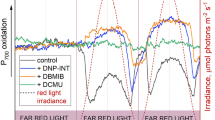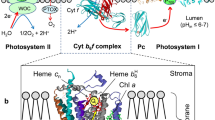Abstract
The triorganotin compounds triphenyltin chloride and tributyltin chloride have been known as inhibitors of the transmembrane proton channel forming F0-domain of ATPases at micromolar concentrations. We show that these compounds at higher concentrations (10–100 µM) also inhibit uncoupled electron transport in chloroplasts within the low potential chain of the cytochrome bf complex. They cause high levels of transiently reduced cytochrome b563 as they decelerate the reoxidation process in flash illuminated chloroplasts. At the same time they slow down the flash induced slow electrogenic step generated at the cytochrome bf complex. The inhibitory effect of triphenyltin chloride on cytochrome b563 turnover in chloroplasts is comparable to that of the Qn-inhibitor MOA-stilbene, with even less side effects on the high potential chain. Studies on the isolated bf complex suggest different binding sites for triorganotins and the quinone analogue type Qn-inhibitors. The results are interpreted within the framework of the modified Q-cycle model by a putative organotin sensitive proton translocating site which enables proton transfer from the outer aqueous face of the membrane to the hydrophobic quinone reduction site within the complex. Hence, cytochrome b563 oxidation and plastoquinone reduction may be inhibited as a consequence of proton transfer being suppressed by triorganotins. In analogy, the previously described inhibitory effect of Val/K+ at the n-side of the cytochrome bf complex [Klughammer and Schreiber (1993) FEBS 336: 491–495] may be rationalised by binding of the cyclic depsipeptide at the entrance of the proton path to the Qn-site.
Similar content being viewed by others
References
Antonenko YN (1990) Electrically silent anion transport through bilayer lipid membrane induced by tributyltin and triethyllead. J Memb Biol 113: 109–113
Asada K, Neubauer C, Heber U and Schreiber U (1990) Methyl viologen-dependent cyclic electron transport in spinach chloroplasts in the absence of oxygen. Plant Cell Physiol 31: 557–564
Avron M (1961) The inhibition of photoreactions in chloroplasts by 2-alkyl-4-hydroxyquinoline N-oxides. Biochem J 78: 735–739
Beattie DS (1992) A proposed pathway of proton translocation through the bc complexes of mitochondria and chloroplasts. J Bioenerg Biomemb 25: 233–244
Bouges-Bocquet B (1981) Factors regulating the slow electrogenic phase in green algae and higher plants. Biochim Biophys Acta 635: 327–340
Cramer WA, Martinez SE, Furbacher PN, Huang D and Smith JL (1994a) The cytochrome b 6 f complex. Curr Opin Struct Biol 4: 536–544
Cramer WA, Martinez SE, Huang D, Tae G-S, Everly RM, Heymann JB, Cheng RH, Baker TS and Smith JL (1994b) Structural aspects of the cytochrome b 6 f complex: Structure of the lumen-side domain of cytochrome f. J Bioenerg Biomemb 26: 31–47
Crofts AR, Meinhardt SW, Jones KR and Snozzi M (1983) The role of the quinone pool in the cyclic electron-transfer chain of Rhodopseudomonas sphaeroides. A modified Q-cycle mechanism. Biochim Biophys Acta 723: 202–218
Emanuel EL, Carver MA, Carlo Solani G and Griffiths DE (1984) Differential inhibition of FoF1-ATPase-catalysed reactions in bovine-heart submitochondrial particles by organotin compounds. Biochim Biophys Acta 766: 209–214
Fowler CF and Kok B (1976) Determination of H+/e? ?ratios in chloroplasts with flashing light. Biochim Biophys Acta 423: 510–523
Gould JM (1976) Inhibition by triphenyltin chloride of a tightlybound membrane component involved in photophosphorylation. Eur J Biochem 62: 567–575
Hacker B, Barquera B, Crofts AR and Gennis RB (1993) Characterization of mutations in the cytochrome b subunit of the bc 1 complex of Rhodobacter sphaeroides that affect the quinone reductase site (Qc). Biochemistry 32: 4403–4410
Hauska G (1986) Preparations of electrogenic, proton translocating cytochrome complexes of the b6f-type (chloroplasts and cyanobacteria) and bc1-type (Rhodopseudomonas sphaeroides). Methods Enzymol 126: 271–285
Hauska G, Schütz M and Büttner M (1996) The cytochrome b 6 f complex – composition, structure and function. In: Ort DR and Yocum CF (eds) Advances in Photosynthesis 4, Oxigenic Photosynthesis: The Light Reactions, pp 377–398. Kluwer Academic Publishers, Dordrecht, The Netherlands
Hauska G, Herold E, Huber C, Nitschke W and Sofrova D (1989) Stigmatellin affects both hemes of cytochrome b in cytochrome b6f/bc1-complexes. Z Naturforsch 44c: 462–467
Hope AB (1993) The chloroplast cytochrome bf complex: A critical focus on function. Biochim Biophys Acta 1143: 1–22
Hope AB and Matthews DB (1987) The slow phase of the electrochromic shift in relation to the Q-cycle in thylakoids. Aust J Plant Physiol 14: 29–46
Hope AB and Rich PR (1989) Proton uptake by the chloroplast cytochrome bf complex. Biochim Biophys Acta 975: 96–103
Hurt E and Hauska G (1982) Involvement of plastoquinone bound within the isolated cytochrome b 6 f complex from chloroplasts in oxidant-induced reduction of cytochrome b6. Biochim Biophys Acta 682: 466–473
Joliot P and Delosme R (1974) Flash-induced 519 nm absorption change in green algae. Biochim Biophys Acta 357: 267–284
Joliot P and Joliot A (1986) Proton pumping and electron transfer in the cytochrome b/f complex of algae. Biochim Biophys Acta 849: 211–222
Jones RW and Whitmarsh J (1985) Origin of the electrogenic reaction in the chloroplast cytochrome b/f complex. Photobiochem Photobiophys 9: 119–127
Jones RW and Whitmarsh J (1988) Inhibition of electron transfer and the electrogenic reaction in the cytochrome b/f complex by 2-n-nonyl-4-hydroxyquinoline N-oxide (NQNO) and 2,5-dibromo-3-methyl-6-isopropyl-p-benzoquinone (DBMIB). Biochim Biophys Acta 933: 258–268
Kallas T (1995) The cytochrome b 6 f complex. In: Bryant DA (ed) The Molecular Biology of Cyanobacteria, pp 259–317. Kluwer Academic Publishers, Dordrecht, The Netherlands
Klughammer C and Schreiber U (1993) Selective interaction of valinomycin/K??+ with the cytochrome bf complex of chloroplasts. Synergistic effect with MOA-stilbene on extent of cytochrome b 563 reduction in continuous light. FEBS 336: 491– 495
Klughammer C, Kolbowski J and Schreiber U (1990) LED array spectrophotometer for measurement of time resolved difference spectra in the 530–600 nm wavelength region. Photosynth Res 25: 317–327
Kramer DM and Crofts AR (1995) A chain reaction mechanism for oxidation of the fully reduced cytochrome b 6 f complex. In: Mathis P (ed) Photosynthesis: From Light to Biosphere II, pp 575–578. Kluwer Academic Publishers, Dordrecht, The Netherlands
Linnett PE and Beechey RB (1979) Inhibitors of the ATP synthetase system. Methods Enzymol 55: 472–518
Martinez SE, Huang D, Ponomarev M, Cramer WA, and Smith JL (1996) The heme redox center of chloroplast cytochrome f is linked to a buried five-water chain. Protein Sci 5: 1081–1092
Matsuno-Yagi A and Hatefi Y (1993) Studies on the mechanism of oxidative phosphorylation. ATP synthesis by submitochondrial particles inhibited at F0 by venturicidin and organotin compounds. J Biol Chem 268: 6168–6173
Mitchell P (1976) Possible molecular mechanisms of the protonmotive function of cytochrome systems. J Theor Biol 62: 327–367
Moss DA and Rich PR (1987) The effect of pre-reduction of cytochrome b-563 on the electron-transfer reactions of the cytochrome bf complex in higher plant chloroplasts. Biochim Biophys Acta 894: 189–197
Oettmeier W, Godde D, Kunze B and Höfle G (1985) Stigmatellin. A dual type inhibitor of photosynthetic electron transport. Biochim Biophys Acta 807: 216–219
Rich PR (1981) Electron transfer reactions between quinols and quinones in aqueous and aprotic media. Biochim Biophys Acta 637: 28–33
Rich PR (1988) A critical examination of the supposed variable proton stoichiometry of the chloroplast cytochrome bf complex. Biochim Biophys Acta 932: 33–42
Rich PR, Madgwick SA, Brown S, von Jagow G and Brandt U (1992) MOA-stilbene: A new tool for the reactions of the chloroplast cytochrome bf complex. Photosynth Res 34: 465–477
Sane PV, Johannigmeier U and Trebst A (1979) The inhibition of photosynthetic electron flow by DCCD. An indication for proton channels. FEBS Lett 108: 136–140
Schreiber U, Hormann H, Neubauer C and Klughammer C (1995) Assessment of Photosystem II photochemical quantum yield by chlorophyll fluorescence quenching analysis. Aust J Plant Physiol 22: 209–220
Selak MA and Whitmarsh J (1982) Kinetics of the electronic step and cytochrome b 6 and f redox changes in chloroplasts. Evidence for a Q cycle. FEBS Lett 150: 286–292
Wang Y and Beattie DS (1991) DCCD binds to cytochrome b 6 of a cytochrome bf complex isolated from spinach chloroplasts and inhibits proton translocation. Arch Biochem Biophys 291: 363– 370
Witt HT (1979) Energy conversion in the functional membrane of photosynthesis. Analysis by light pulse and electric pulse methods. The central role of the electric field. Biochim Biophys Acta 505: 355–427
Author information
Authors and Affiliations
Rights and permissions
About this article
Cite this article
Klughammer, C., Heimann, S. & Schreiber, U. Inhibition of cytochrome b563-oxidation by triorganotins in spinach chloroplasts. Photosynthesis Research 56, 117–130 (1998). https://doi.org/10.1023/A:1005998729041
Issue Date:
DOI: https://doi.org/10.1023/A:1005998729041




